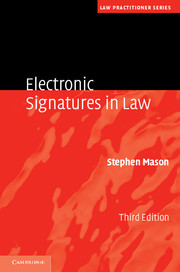Book contents
- Frontmatter
- Contents
- Preface
- Acknowledgements
- Table of cases
- 1 The signature
- 2 International initiatives
- 3 European Union Directive on electronic signatures
- 4 England and Wales, Northern Ireland and Scotland
- 5 International comparison of electronic signature laws
- 6 The form of an electronic signature
- 7 Digital signatures
- 8 Liability
- 9 Evidence
- 10 Data protection
- Index
- References
6 - The form of an electronic signature
- Frontmatter
- Contents
- Preface
- Acknowledgements
- Table of cases
- 1 The signature
- 2 International initiatives
- 3 European Union Directive on electronic signatures
- 4 England and Wales, Northern Ireland and Scotland
- 5 International comparison of electronic signature laws
- 6 The form of an electronic signature
- 7 Digital signatures
- 8 Liability
- 9 Evidence
- 10 Data protection
- Index
- References
Summary
While it is possible for an electronic signature to perform the same functions as a manuscript signature, the document to be signed does not exist as a physical object in the same way as the content of a document rendered onto a paper carrier. It is not necessarily intended that an electronic signature should be manifest in a physical form, which leads to the conclusion that the quality and extent of the evidence to provide intent becomes vitally important in the event it is disputed that an electronic signature was affixed to a document or communication.
Information relating to the carrier
When a manuscript signature is affixed to a physical carrier, two changes occur. First, the signature alters the carrier physically with the addition of a substance, such as ink, to the surface. Second, the signature increases the amount of information about the carrier, and thereby the document. An electronic signature, on the other hand, only tends to alter the information relating to the digital data. It does not necessarily alter the carrier in the same way as a manuscript signature, although an inline Pretty Good Privacy signature, for instance, is read with the message. The information associated with the carrier is termed the metadata. The metadata refers to the data about data. It is a digest of the structure and subject matter of a resource. For instance, the metadata in relation to a piece of paper may be:
Explicit from perusing the paper itself, such as the title of the document, the date, who wrote it, who received it and where the document is located.
Implicit, which includes such characteristics as the types of type used, such as bold, underline or italic; perhaps the document is located in a coloured file to denote a particular type of document; labels may also act as pointers to allow the person using the document to deal with it in a particular manner, such as a confidential file, for instance.
With digital documents, the implicit data needs to be made explicit if it is to be used to help interpret the purpose of the document. Such data can include, and be taken automatically from, the originating application software, or supplied by the person that originally created the record. As a result, a digital record will normally contain two main types of information, the content of the document and its internal structure, and the metadata, which describes the record and each of the constituent parts.
- Type
- Chapter
- Information
- Electronic Signatures in Law , pp. 187 - 258Publisher: Cambridge University PressPrint publication year: 2012

